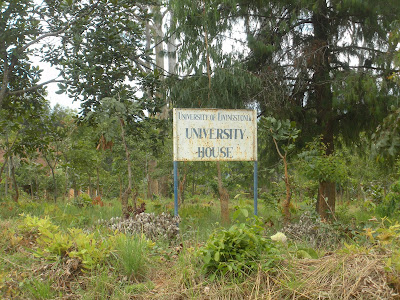From Nkata Bay, my sister and I got ourselves to Mzuzu via a shared taxi and then to Chitimba via a minibus. Our goal for this day’s travels was an eco-lodge called Mushroom Farm high on the Livingstonia Escarpment. To get the Mushroom Farm, you have to walk or drive about 15km and 700m of elevation gain to get there. We decided to walk up with our backpacks. The first third of the walk was hot, sunny, and without shade, and starting the hike at 1pm didn’t help. The second third of the hike is very steep with about a dozen hairpin turns to go up. This is why the hike takes 2-3 hours or 1 hour in a car. It is steep, curvy, and a badly maintained road. The last third is reasonable but I was tired and it seemed very long. Karyn was very nice and walked the whole way with two sisters we met in Nkata Bay. They were slow and badly unprepared as they weren’t wearing socks, had short jean shorts on, minimal sun protection, and no jacket (it gets cold at night).
Mushroom Farm and Livingstonia is neat because mainly because of the natural beauty but also for the history. It is one of the few places in Africa we visited that has some historical things you can visit. Mushroom Farm sits right at the edge of the escarpment and you can look down 700m to the ground below and look out and see Lake Malawi and even Tanzania on the other side of the lake. The area around Mushroom Farm is very jungle like with lots of vegetation and spiders, and we actually got a downpour of rain on morning for about 15 minutes. It’s an eco-lodge in a beautiful place.
Livingstonia is named after David Livingstone and was, and still is, an important mission site of the CCAP (Church of Central Africa Presbyterian). Dr. Livingstone died before he was able to start his mission, and a few years and tries later, the group he was doing this will founded Livingstonia (named after him) and the mission. For this reason, there is a very nice stone 100+ year old church, a university, technical college, and secondary and primary school. The missionaries began all these institutions and they are active today. The missionaries have been so influential that when Malawi gained its independence from the UK in the 1950’s, most of the leaders were educated at one point in Livingstonia.
The town is surprisingly small considering the historical, cultural, and educational significance of it. With it being small, it is easy to navigate and tour the church, small museum, university, market, and stone cairn marking one of the first deaths of the mission. The town is about 10 km from Mushroom Farm and an easier hike to get there.
Between the Farm and town, there is a 125m waterfall which is one of the largest in Malawi. It was so unexpected to see it because while the escarpment is lush and green, there isn’t much running water on the ground. I also found out that the slave trade use to be big in the area in the 1700 and 1800’s and local would hide behind the waterfall to escape the slavers.
Karyn and I spend a one full day here and two partial days but the big reason for the trip was to do a five-day trek to Malawi’s first national Park, Nyika NP. I’ll talk about that part of the trip in the next post.
 |
| We camped at Mushroom Farm and this was the view! |
 |
| Celebration after reaching the Farm |
 |
| In and around Livingstonia, there were they beautiful houses that had plants growing on them. |
 |
| Church in Livingstonia |
 |
| Idea of the vegetation and how well kept things are in Africa |
 |
| Stone cairn |
 |
| Reason for stone cairn. There are lots of these "some camped here" monuments....random. |
 |
| Waterfall |
 |
| Karyn hiding from slavers |
 |
| View of Lake Malawi from the top of the escarpment |
 |
| I thought this house was so beautiful but the kids would not let me take a photo without people |
 |
| View for Livingtonia towards the lake |
 |
| One of my favorite things of Malawi is the poinsettia bushes. They are so neat. |
 |
| Pastime of all Malawians is pool. There are pool table in nearly all town markets. |
















No comments:
Post a Comment